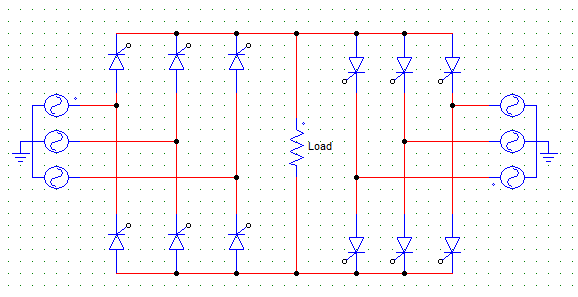This set of Power Electronics Multiple Choice Questions & Answers (MCQs) focuses on “Dual Converters-2”.
1. In circulating current mode dual converters, the circulating current is avoided by
a) connecting a series reactor
b) maintaining α1 + α2 = 180°
c) operating only one converter
d) adding an extra SCR
View Answer
Explanation: Reactor is added in circulating current mode not in non-circulating mode. The reactor limits the current to a reasonable value.
2. Choose the correct statement
a) Circulating current exists only in circulating current mode
b) Circulating current exists only in non-circulating current mode
c) Circulating current exists in both the circulating and non-circulating current mode
d) none of the mentioned
View Answer
Explanation: The circulating current does exist in both the converter circuits, but it is avoided by using a reactor in non-circulating type and by operating only one circuit in case of circulating type.
3. What causes circulating current in dual converters?
a) Temperature issues
b) Inductance in load circuit
c) Out of phase voltages from both the converters
d) none of the mentioned
View Answer
Explanation: In case of practical dual converters, the voltages from both the converter circuits though equal in magnitude is out of phase. This indifference in voltages causes circulating currents to flow.
4. Name the below given circuit.

a) Single-phase dual converter with circulating current type
b) Single-phase dual converter with non-circulating current type
c) Three-phase dual converter with non-circulating current type
d) Three-phase dual converter with circulating current type
View Answer
Explanation: The circuit is a three phase dual converter circuit. As the there is no reactor (inductor) in series, it is a non-circulating type.
5. In case of three-phase dual converter, one of the converter circuits is fired at an angle of 60°. For both the converter circuits to have equal average output voltage, what is the value of the firing angle for the other converter circuit?
a) 60°
b) 120°
c) 100°
d) Insufficient data
View Answer
Explanation: For equal average output voltage, α1 + α2 = 180°.
6. In case of circulating current type dual converters, the reactor is inserted between
a) supply and converter
b) across the load
c) between the converters
d) no reactor is used in case of circulating type dual converter
View Answer
Explanation: Reactor (inductance) is added in circulating current mode between both the converters. The reactor limits the current to a reasonable value.
7. Choose the correct statement.
a) Circulating current type is faster in operation
b) Non-circulating current type is faster in operation
c) Both the types have the same speed of operation
d) Circulating current improves power factor
View Answer
Explanation: In case of non-circulating type, to shift the operation from one mode to another mode a delay of 10 to 20msec is required to let the current decay to zero value and let the outgoing SCRs safely turn off. This delay is not required in case of circulating current mode.
8. Circulating current flows
a) from load to converters
b) from one converter to another converter
c) in the whole circuit
d) none of the mentioned
View Answer
Explanation: The circulating current flows only between the converters and not to through the load.
9. The reactor in circulating current type dual converters
a) increases losses
b) reduces power factor
c) increase the weight of the circuit
d) all of the above
View Answer
Explanation: All of the above mentioned are the major drawbacks of using reactors to reduce circulation current.
10. If V1 and V2 are the instantaneous voltages of the two converter circuits in the dual convert, then the output voltage is
a) V1 + V2
b) (V1 + V2)/2
c) V1 – V2
d) 2(V1 + V2)
View Answer
Explanation: The load voltage is the average value of the instantaneous converter outputs.
Sanfoundry Global Education & Learning Series – Power Electronics.
To practice all areas of Power Electronics, here is complete set of 1000+ Multiple Choice Questions and Answers.
If you find a mistake in question / option / answer, kindly take a screenshot and email to [email protected]
